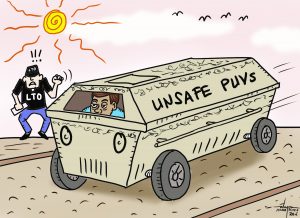Now Davao City is overtaken by General Santos City. That is, as far as the construction of a septage treatment plant is concerned.
Yes, the city of the world famous tuna is already implementing its P125 million waste water treatment plant under a partnership between the city government and the General Santos City Water District (GSCWD).
According to a report published in a Davao City daily emanating from General Santos the plant will ensure the proper treatment and disposal of septage from the thousands of households and establishments of the fast developing city. In effect, added the report, it will help promote the health and safety of the people in that part of Mindanao.
The construction is made possible after the local government of General Santos and the GSCWD signed a memorandum of agreement (MOA) that defines the responsibilities of both parties concerning the construction and operations of the waste water treatment plant.
As to the much bigger Davao City, the septage project is still very much in the air. An earlier report quoting an official of the local water firm disclosed that the Davao City Water District (DCWD) is already prepared to implement the project. What the agency is waiting is for the approval by the Davao Sangguniang Panlungsod of the draft MOA between the two entities.
According to the DCWD official, it’s been sometime already since the MOA draft has been forwarded to the City Council. Somehow, the local legislators are taking their time on the document.
This is something that we cannot really understand. For a city that has been considered economically in bloom and with a population of roughly 1.7 million, it is easy to imagine the level of waste water being discharged by households, business establishments and industrial plants every day of the year.
And for the absence of a septage facility all the dirt, the toxic elements being discharged through the water used by households, businesses, and industries go direct to the city’s drainage system and down to the creeks, rivers and other water ways. Nothing stands on its way towards polluting the waters of the city’s beaches.
Is not the septage plant self-liquidating? From what we’ve heard those who will connect to the plant will have to pay certain amount and this is included in the billing of DCWD to its customers. In other words, the system of the plant’s operation is designed in a manner that it can pay for the expenses incurred in its construction and sustenance.
So, what’s taking it too long for the City Council to decide if the draft MOA is in accordance with the intentions of the project?
*******************
This time, we are taking up a subject still about environment and the efforts being done to protect its quality. In the preceding topic the issue is on water pollution in Davao City that is supposed to be addressed with a waste water treatment plant project. And like the General Santos case, the project is to be undertaken by the city’s water supplier, the Davao City Water District (DCWD).
This second topic in our today’s column is on the potential pollution of the city’s air that the millions of Davaoenos breathe every second of their lives. Yes, the issue is about the possible worsening of the air quality in the city with the construction and operation of a waste-to-energy (WTE) project in Biao Escuela in Tugbok district.
According to a report, work on the P2.5 billion WTE project is slated to start before the end of this year. Meaning, the construction of the WTE could start possibly in the next two weeks or in the month of December (next month).
A WTE plant is a power-generating facility that burns solid household, commercial establishment and industrial wastes and converts the same into energy. The Biao Escuela project hopes to burn the various solid garbage dumped at the New Carmen Sanitary Landfill that is already full to the brim.
But this early, there are sectors in the city that believe the burning of garbage will produce not only obnoxious odor but also toxic smoke. Therefore, the opposition groups to the WTE, led by No Burn Philippines, think that the operation of a WTE in Biao Escuela could lead to the further deterioration of the air quality in the city.
This, notwithstanding the assurance of the Department of Environment and Natural Resources (DENR) that it will not pollute the city’s air.
Well, as we have always pointed out, in development there will always be sufferers, much as there will be beneficiaries. But its real measure is whether the project will benefit more people than those who may suffer from it.
Which of the two – beneficiaries and sufferers – will have the bigger number?


